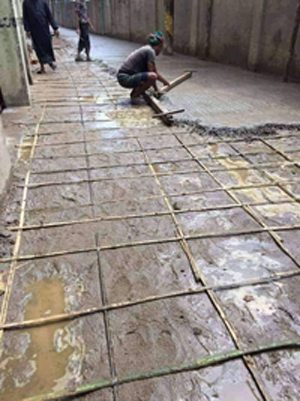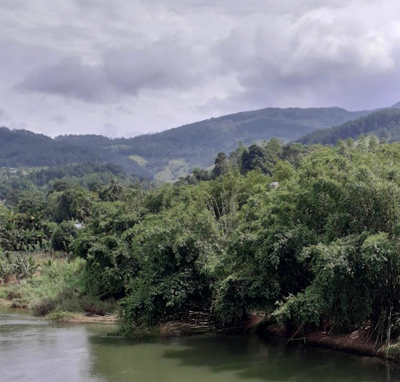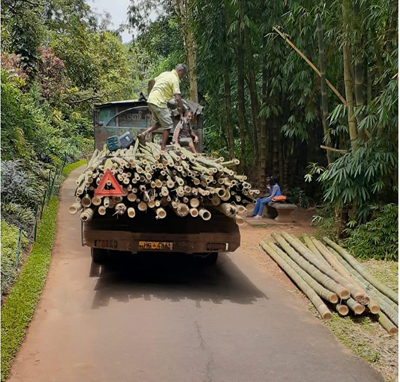Back to bamboo, a forgotten resource

Bamboo reinforced concrete
It has been called the “cradle to coffin plant” or the “poor man’s timber” for its benefits to rural communities. But now bamboo has become a miracle plant, the “Green gold”!
Bamboo has immense economic and environmental potential. Sri Lanka however although situated in the natural bamboo growing region of the world with a long history of making traditional bamboo handicrafts, is still lagging behind many countries across the world that have expanded their bamboo industry.
Bamboo belongs to the family of grasses, the Poaceae with herbaceous, bushy and woody tree-like forms. Woody bamboos have come into prominence due to their economic and environmental benefits. They attain tree-like proportions but have the main characteristics of the grasses, an underground system of root bearing branches termed the rhizome from which the aerial branches or the culms emerge. The culms grow at the rate of one foot per day to reach a height of even 60 feet within two months in the giant bamboos. Thus they are the fastest growing plants on earth.
These culms mature in three to four years developing mechanical tissues and are also flexible due to the hollow nature of the stem. The mechanical tissue is lignocellulose, which is the strengthening material common in the plant kingdom. Woody bamboos are the fastest growing wood source in the world!
Once planted, bamboo can be harvested within six years, unlike timber trees which take 50 to 60 years to mature. Bamboo can be harvested sustainably for long periods as new culms emerge every year. It needs little or no fertilizer and irrigation.

Bamboo planted along the Mahaweli bank
In the past, bamboo was used only in low value temporary constructions because it decays rapidly due to the presence of starch and sugars that attract pests. Now new methods of bamboo preservation have been developed and processed long lasting bamboo products that can be substituted for timber are being manufactured. Bamboo mat board, PLY bamboo, floor boards, panelling, MDF, strand woven bamboo etc. are now used in making furniture and housing. These products can reduce the pressure on harvesting valuable trees from forests.
The construction sector may be revived with the use of processed bamboo and even bamboo reinforced concrete. Low cost bamboo housing is now popular in many countries and cabanas and cottages made entirely of bamboo are becoming a fashion in the tourist industry. There is scope for all this in Sri Lanka.
Sri Lanka has only a few (10) endemic small diametre reed bamboos. Many useful species have been introduced are now naturalised. In the past, the bamboos were harvested from wild stands and to control overexploitation, legislation was made by the Forest Department. The Crown Lands Ordinance No. 8 of 1947 defines a “tree” to include bamboos along with certain other trees, palms, brush wood etc. Subsequent Forest Amendment Acts have not changed this definition. It is necessary to get permits to harvest bamboo from State lands and to transport them. However, although a permit is not required to harvest from private lands, one is required for transport.
Getting this permit is a cumbersome process as it involves many organisations starting from Grama Niladhari, to Divisional Secretariats, Central Environmental Authority, Forest Department etc., depending on the extent of land, and the number of poles to be harvested and transported! This has discouraged many an entrepreneur and unharvested bamboo are seen perishing in most places.

Permit required: Bamboo being transported
However, the present extent of land under bamboo has increased with new planting especially with the functioning of the Riverine Bamboo project of the Mahaweli Authority in 2004. Their tissue culture laboratory in Mawatura, Kotmale claims that they have planted over one million bamboo plants mostly along the banks of the Mahaweli river and other Mahaweli areas. Many of the bamboos are fully grown and not harvested or maintained by any organisation.
Bamboo is not harvested from riverine areas as they are considered unique and sensitive areas and bamboo in such localities has the same definition as a “tree” in the National Heritage and Wilderness Areas Act where removal of even a part of a plant is prohibited. It is thus essential for Government intervention to relax these regulations according to the present.
The global bamboo market is projected to be valued at US dollars 100 billion by 2026 due to its rediscovery as a timber substitute. The demand for sustainable green products which can also be turned out from bamboo is increasing in the global market.
While many other countries are turning to bamboo to support their socio-economic and environmental policies, Sri Lanka has still not recognised bamboo at a national level, mainly due to a lack of understanding among policy makers of the ecosystem services and industrial potential provided by bamboo. Thus bamboo still remains an untapped avenue for economic, environmental and social benefits. The few and scattered bamboo industries have not shown a significant expansion. The local market is only limited to turning out blinds (for export too), handicrafts, incense sticks, furniture, fresh edible bamboo shoots, ornamental bamboo plants, charcoal, biochar and raw bamboo poles.
In 2011, Sri Lanka imported USD 0.5 Mn. worth bamboo related products which grew by 40% in 2015. Bamboo flooring as a substitute for wood flooring accounted for nearly 60% of the total trade value. The other imported bamboo products are yarn for textile industry, wood based panels, charcoal, canned edible shoots, bamboo sticks for incense industry, and other home utility items.
Now most of the imports have been banned but many of them could be produced in Sri Lanka, if the raw material and technology are available. The bamboo sector in Sri Lanka is a stagnated, fragmented industry with many institutions working on their own.
Currently the main stakeholders are the Mahaweli Authority of Sri Lanka, Industrial Development Board, Forest Department, National Craft Council, private companies, plantation companies and R & D Institutes. Sri Lanka has received foreign grants from IDRC, NORAD, CFC and UNIDO over the years for bamboo industrial development but little appears to have happened.
It is imperative that Sri Lanka formulates a National Strategy and Action Plan to recognize bamboo as a high value industrial crop. This will initially require an in-depth study of the prevailing status of the resource and its applications from low to high tech industrial levels and the possibilities for expansion.
The main concerns that need to be addressed immediately are:
- Relaxing the existing laws on harvesting and transport of bamboo.
- Amending the laws on harvesting bamboo planted on riverine areas.
- Releasing state land not used for agricultural or other purposes for bamboo cultivation and due consideration given for tenure and ownership of the resource to encourage farmers.
Bamboo is a ‘forgotten resource’ in Sri Lanka in terms of achieving sustainable development goals, which encompass the reduction of rural poverty, achieving economic growth, providing environmental protection and mitigating climate change.
Searching for an ideal partner? Find your soul mate on Hitad.lk, Sri Lanka's favourite marriage proposals page. With Hitad.lk matrimonial advertisements you have access to thousands of ads from potential suitors who are looking for someone just like you.


